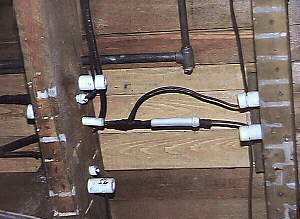Phone or Text Fairfield Electric
Mail: 632-A Wilson Street
Victoria BC V9A 3H2
Knob and Tube Wiring
We are experts at assessing, repairing, removing and replacing knob-and-tube wiring. Many houses in Victoria still have this type of wiring functioning and we work with it all the time. It is not inherently dangerous and it still complies with Electrical Code Regulations in most cases.
Some insurance companies stipulate that knob and tube wiring must be removed from any house before they will insure it. If you have knob and tube and wish for a professional assessment, or to have it removed and replaced with modern wiring, call Fairfield Electric Victoria BC and we can take care of it. Should wiring need to be replaced, we are the experts. We have developed techniques to run new wiring inside walls and ceiling without having to cut wall surfaces open, at least in many cases. Should wall or ceiling repair be necessary, we can organize the work for you, including painting.
Knob and tube wiring was an early standardized method of electrical wiring in buildings and commonly used in North America from about 1880 to the 1930’s.

Knob and tube wiring consisted of single insulated copper conductors run within wall or ceiling cavities, passing through holes drilled in joists and studs, via protective porcelain insulating tubes, and supported along their length on nailed-down porcelain knob insulators. It is not run in conduit.
The problem with knob and tube is the insulation. At the time it was popular its temperature rating was 60c. This is the max temperature the insulation is supposed to be able to withstand. At present, the minimum temp rating on residential wiring is in most cases, 90c. The result is that anyplace you can expect very much heat, you can expect the jute and tar material composing the insulation to be overheated, resulting in a brittle material that will break off if the cable is flexed. Where we most often find heat-damages jute insulation is in ceiling light fixtures. In the old days lights were not so hot as they are today, so the first place we look for damaged insulation is in the ceiling fixtures.
We can often cure damaged insulation cheaply with heat shrink tubing. It is a straightforward job and only very rarely requires opening up wallboard; the work can usually be done from inside the fixture box.
We have done hundreds or knob-and-tube remediation jobs here in Victoria BC. We are happy to answer any questions anytime at 250-885-1227.
You can see a very good article on the subject here.
